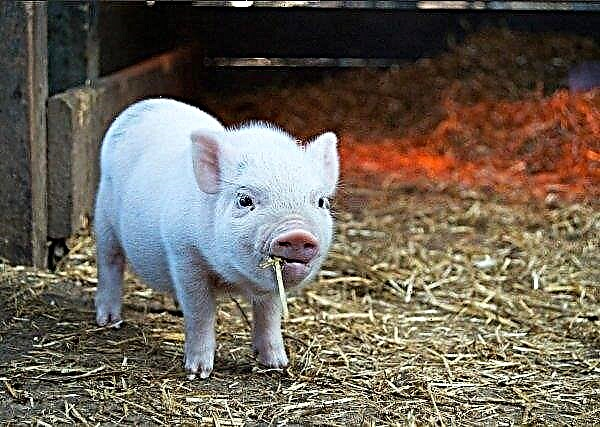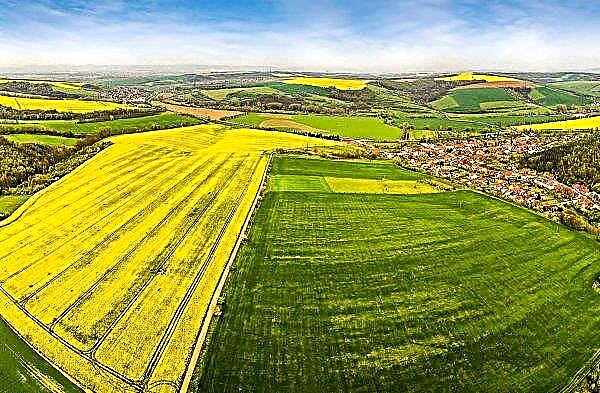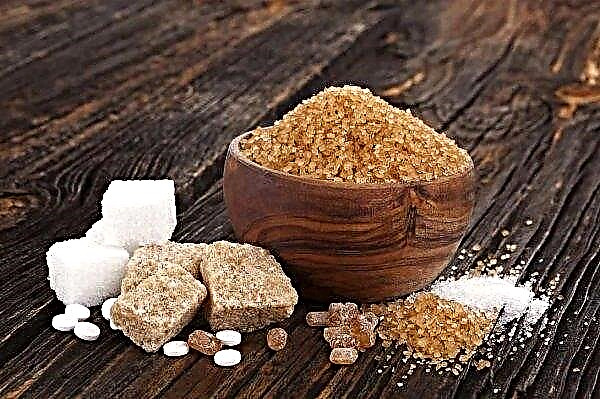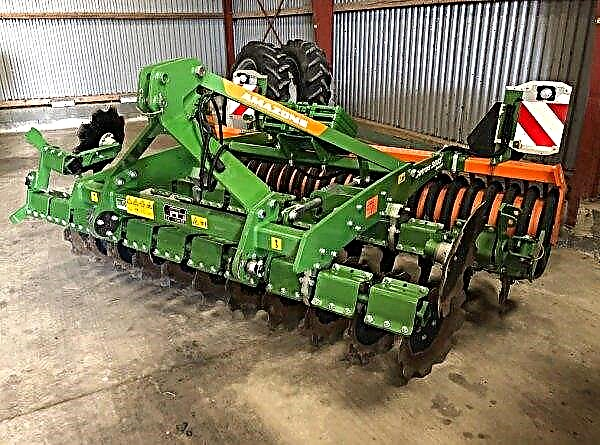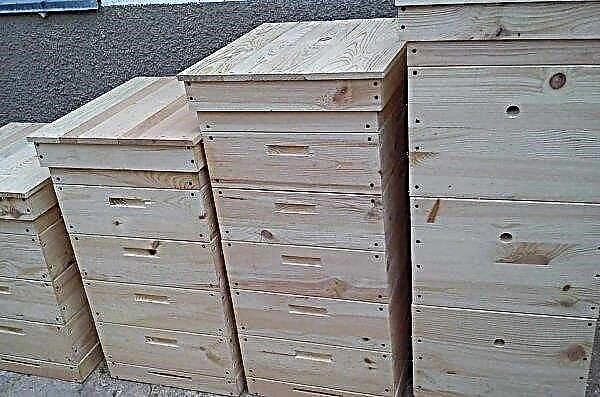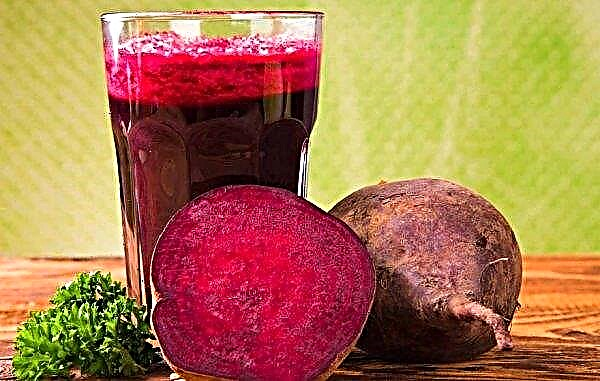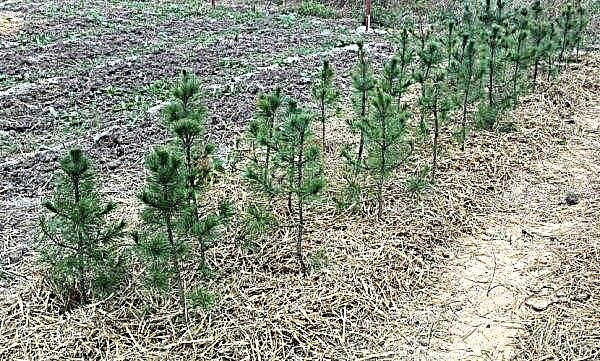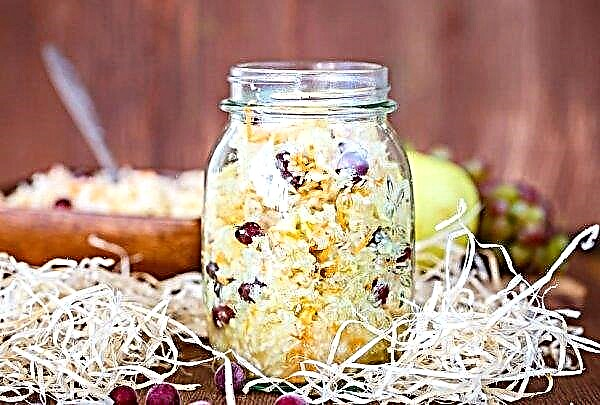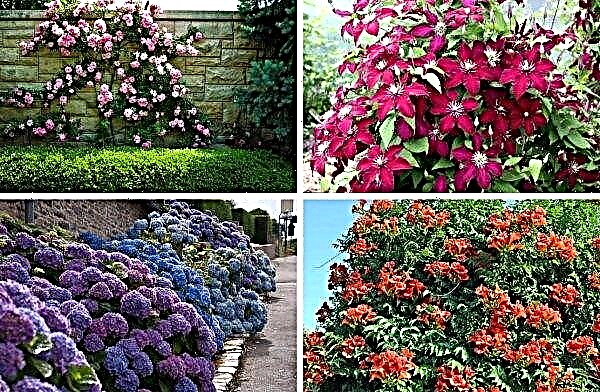Flowering panicle hydrangea bushes are grown in many garden plots, being a bright decoration of any locality. One of the most decorative varieties is considered Touch of Pink, whose representatives are small and delicate peach color petals. A brief description of the shrub, the features of its use for decorating the territory, as well as recommendations for planting and growing plants, are further described in the article.
Hydrangea Touch of Pink in landscape design
Representatives of this variety differ from other instances of hydrangea paniculate compact in size, therefore, they are convenient for growing even in small garden areas.
Brief description of the bush:
- The maximum height of the plant is 0.8 m, and the width of the spreading round crown is up to 1 m.
- The leaves are dark green, oval in shape, densely covering the shoots of the plant.
- The flowering period lasts from late June to early October. A young shrub blooms the very next summer.
- Inflorescences are small, delicate, about 10 cm wide. They have a conical shape and a pointed tip.
- The diameter of one flower is up to 2 cm. The petals are first white, and by the end of flowering they acquire a pink color.
Did you know? In Japan, hydrangea is called adzisai. This word translates as "purple sunny flower."
Due to its miniature nature, the new Hydrangea paniculata Touch of Pink panicle hydrangea variety is used in the art of landscape design:
- in single landings;
- as a constituent element of mixed compositions from other ornamental plants;
- to create a miniature live fence of the territory;
- in mixborders.
How to plant
The process of planting hydrangea Touch of Pink is not complicated, but is carried out according to some rules. Before planting a seedling in open ground, you need to find a site with suitable conditions, and also perform the entire procedure in a short time. Particular attention is paid to the quality of planting material and proper soil preparation, and the bush planting procedure itself should be carried out according to a certain algorithm.
Video: how to plant hydrangea
Landing time
To choose the most suitable time for planting a crop, you need to take into account the geographical location of a particular region. In areas with a cold and temperate climate, it is recommended to plant bushes in early May so that they are not exposed to night frosts. In the southern regions, in addition to spring planting, you can perform the procedure in the fall, a month before a significant cooling - about the beginning of September.
Seat selection
In order to accelerate the rooting of the seedling and ensure lush, regular flowering in the future, it is necessary to find a site with optimal conditions for planting Hydrangea Touch of Pink.
The place is chosen by the presence of such criteria:
- good illumination in the morning and evening, but partial shade during the day - under constant sunlight the bush burns out, and with strong shading it loses its decorativeness;
- loose, nutritious soil with a high level of acidity (pH 5.0) - the amount of inflorescences on the bush and the intensity of their color depends on the composition of the soil;
- lack of groundwater at a depth of less than 1.5 m - hydrangea roots react negatively to excess moisture and begin to rot;
- protection against drafts - in such conditions, the plant's immunity weakens, and with a strong wind, the shoots of the bush break.
Important! Panicled hydrangea should not be planted near large trees. They will absorb all moisture from the soil, as a result of which the flowering of the shrub will be very sparse.
Preparing planting material
The quality of planting material depends not only on the rate of adaptation of the plant to new conditions, but also on the decorative qualities of leaves and inflorescences. Therefore, young copies of hydrangeas intended for planting are recommended to be purchased in nurseries.
The high quality of the seedling is evidenced by such signs:
- age 3-4 years;
- the presence of 2-3 developed lateral branches;
- elastic leaves having a uniform and saturated color;
- smooth, flexible trunk without damage and traces of disease;
- branched root system, consisting of elastic and strong processes.
 Immediately before planting, it is recommended to soak the hydrangea roots in a solution of potassium permanganate for 30 minutes - this will protect the plant from diseases. Too long shoots can be slightly shortened with a sharp garden tool.
Immediately before planting, it is recommended to soak the hydrangea roots in a solution of potassium permanganate for 30 minutes - this will protect the plant from diseases. Too long shoots can be slightly shortened with a sharp garden tool.
Panicle hydrangea planting
Digging pits 2-3 days before the procedure. They must fully accommodate the root system of the seedling, having a diameter of up to 0.4 m with a depth of about 0.5 m.
To fill the recesses, a special substrate is prepared by mixing the following components:
- 2 parts of humus;
- 2 parts of garden land;
- 1 part peat crumb;
- 1 part of sand.
If a gardener plants several hydrangeas on a plot at once, then a distance of at least 1 m must be left between them.
A step-by-step landing instruction is as follows:
- Put a layer of pebbles or brick fragments into the hole.
- On top of the drainage, form a small hill of loose soil mixture.
- Set the seedling in the center of the recess so that its root neck is not buried in the ground.
- Cover the roots of the flower with soil. Gently press the surface of the earth with your hands to make a small barrel circle.
- Pour 10 l of settled warm water under the base of the bush.
- When the liquid is completely absorbed, mulch the area with humus or peat.

How to care
If the gardener has correctly planted, then hydrangea takes root quickly. In the future, the bush needs proper care, consisting of regular irrigation, periodic top dressing, annual pruning. With the onset of autumn, it is necessary to begin preparing the plant for winter, constructing a small shelter around the flower.
Did you know? Hydrangea was brought to Europe by Louis-Antoine de Bougainville, the leader of the first French round-the-world expedition. In 1768, he found a flowering shrub unknown to him on the island of Mauritius and brought it to his native country.
Watering
Hydrangea Touch of Pink is a moisture-loving crop. With a lack of water, shoots and inflorescences begin to wither, but waterlogging of the soil also has a detrimental effect on the roots of the plant, therefore, when watering it, these recommendations are followed:
- in the absence of rain the bush is watered every 5-7 days, and in hot weather - every 3 days;
- for irrigation plantings use warm, settled water without chlorine;
- watering is performed in the morning or evening hourspouring liquid under the root - drops of moisture should not fall on the green mass and flowers, as this will lead to the loss of the decorative appearance of the bush;
- per copy 15–20 L of water is required.
Video: how to feed and how to water hydrangea
Top dressing
Hydrangea Touch of Pink responds well to top dressing, so you need to regularly fertilize the soil near the flower. For the first time, this procedure is performed the next spring after planting a seedling. Depending on the stage of the bush’s life cycle, certain components are used at different times.
Feeding hydrangea involves several stages:
- in April 25 g of urea, 35 g of superphosphate and 35 g of potassium sulfate are added per 1 m² of area;
- before flowering the plant is fed 70 g of superphosphate and 45 g of potassium sulfate (the amount is indicated per 1 m²);
- one month after the start of flowering add organic fertilizers in the form of a 20 liter solution of chicken droppings per plant - to prepare the concentrate, mix the substance with water (in a ratio of 1: 3), and then add 1 liter of liquid to 10 liters of clean water;
- organic top dressing carried out twice a season with an interval of two weeks - when re-introduced instead of chicken droppings, you can use manure, observing the same dosage of fertilizer.
Important! To make panicle hydrangea branches stronger, it is recommended to irrigate the plant with potassium permanganate 2-3 times a season. The crystals of the substance are added to water for irrigation, and then the agent is mixed well.
Mulching
Periodically, the earth near the flower may be covered with a dense crust, which impedes the access of water and air to the roots of the plant. Therefore, it is recommended to loosen the soil near hydrangea, combining this procedure with the removal of weeds. For the best effect, perform such actions on wet ground.after each irrigation or rain. In order for the soil to remain loose for a long time, the trunk circle is sprinkled with peat or dry needles.
Pruning
In order for panicle hydrangea to flourish splendidly, and its crown retained its neat shape, annual bush cutting is carried out. For the first time, this procedure is performed when the seedling reaches the age of 4-5 years.
When pruning a bush, follow the basic rules:
- the shoots are shortened after the snow melts, before the sap flow begins;
- the procedure is performed using a sharp garden tool;
- without fail, broken and dried branches are removed;
- on each plant, only 6–10 of the strongest (skeletal) shoots are left;
- large branches shorten up to 2-3 buds, making cross sections;
- weak and thin shoots growing inside the crown are completely cut out;
- only dried inflorescences are removed in the fall - the shoots are not shortened to prevent the weakening of the bush before frosts.

Winter preparations
In order for Hydrangea Touch of Pink to successfully survive the winter, it is necessary to properly prepare it for lowering the temperature.
To do this, perform the following actions:
- watering is stopped in mid-September, so that the plant gradually goes into a dormant state;
- remove garbage from the adjacent territory;
- tear off the leaves at the bottom of all shoots, so that the branches lumber faster;
- the plant is slightly covered with earth, forming a hill 20-30 cm high;
- to protect the roots, the soil around the bush is mulched with a layer of peat, rotted manure;
- hydrangea branches are pulled together using a braid or a soft rope - this will prevent breaking of shoots under the weight of the snow cover.
Video: preparing panicle hydrangea for winter
Shelter of the bush for the winter
Panicled Hydrangea Touch of Pink belongs to the winter-hardy crops. Adult bushes can survive a cold snap to -35 ° C, but in regions with a temperate and cold climate, it is recommended to cover plants. Young specimens in the first years after planting are especially in need of protection from frost.
Did you know? Hydrangea got its Latin name due to its high demands on soil moisture. The name of the flower consists of the words "hydor" - water and "aggeion" - a vessel.
The basic rules of sheltering culture for the winter:
- protection is established in mid-October, and removed around the end of April;
- the branches of young plants are completely tilted to the ground and fixed;
- several vertical wooden supports are driven around adult bushes - they should be 10-15 cm above the bush;
- the shoots bent to the ground are covered with dry sawdust and spruce branches, and if there is a frame, its inner space is filled with dry foliage;
- in areas with severe weather conditions, the plant is additionally covered with lutrasil or roofing material on top, fixing it with stones or bricks.

Hydrangea propagation
If the gardener already has one instance of the Touch of Pink variety on his plot, then new young plants can be obtained from it using various propagation methods. You can grow a bush from seeds collected independently after flowering. But the most commonly used cuttings and layering, which are selected from the side shoots of a flower.
Seeds
The seed method of reproduction of panicled hydrangea Touch of Pink is used very rarely due to the fact that it is quite time-consuming. First you need to prepare the seeds (they are inside a small fruit box, which is formed from fertile flowers after the flowering period has ended). Then the planting material is slightly dried, placed in an envelope of paper and put away for storage. Planting seeds is performed in the last month of winter.
Important! If buds have appeared on a recently planted panicle hydrangea bush, it is recommended to pick them off. This will allow the plant to concentrate all its forces on the active growth of shoots and leaves.
Step-by-step instructions for seed propagation include the following:
- Cover the seeds with wet gauze and leave at room temperature for 2-3 days for germination, periodically moistening the fabric with warm water.
- Prepare a container (flower pot, box). Pour into it a soil mixture consisting of garden soil, sand and peat (in a ratio of 1: 1: 1).
- Put germinated seeds on the surface of the substrate. To fill up with the sand moistened with settled water.
- Create a greenhouse effect by covering the box with film or glass. Put it in place with ambient light at an air temperature of up to + 20 ° C.
- In the process of seed germination, spray the soil with spray water. Raise the film daily so that the sprouts do not become barred from high humidity.
- Shoots appear after 2-3 weeks. After this, remove the shelter completely. At the stage of emergence of seedlings of 2-3 leaves, transplant them into small individual containers.
- Grow sprouts at a temperature of + 20 ° C and bright diffused lighting. Moderately water the seedlings, observing the moisture of the substrate.
- In the summer season, twice a month to feed seedlings with complex fertilizer for flowers.
 At room conditions, panicle hydrangea seedlings are grown for two years, and then the seedlings are transplanted to the site.
At room conditions, panicle hydrangea seedlings are grown for two years, and then the seedlings are transplanted to the site.
Cuttings
This method of reproduction is the simplest. Cuttings of annual shoots obtained during the shearing of the crown of the bush in spring or early June are used as planting material. They are rooted in a box with earth and grown indoors for two years, and then moved to the site.
Step-by-step instructions for propagation of hydrangea by cuttings:
- Cut the top of a green shoot up to 10 cm long from the bush. It should have 6-7 buds and several green leaves.
- Remove the lower leaves on the cut piece and shorten the rest by 1/2 length.
- Lower the shoot into the water for a couple of days (side without leaves). Then stand it for two hours in a solution of "Kornevin."
- Prepare a container with sand and peat crumbs (ratio of ingredients 1: 2).
- Make a depression in the soil (2-3 cm) with a thin stick. Immerse in it that part of the stalk from which the leaves were removed.
- Lightly moisten the substrate in the container. Cover the shoot with a plastic or glass cap.
- Put the container in partial shade, periodically removing shelter from the handle. Moderately water the substrate around the seedling when it dries.
- After the rooting process is completed (after 15–20 days), remove the jar. Move the container to a lit place, observing the previously established irrigation schedule.
- For winter, remove the seedlings in a cool place. Water very moderately, no more than three times a month.
Layering
Another commonly used method of propagating a crop is the layering method. It allows you to get a young flower with a full range of the same varietal characteristics that are present in the mother plant.
Did you know? At first, Europeans grew hydrangea exclusively as a houseplant. Varieties intended for landscaping the open territory were bred only at the beginning of the twentieth century by French breeders.
Step-by-step instructions for reproduction by layering:
- Choose a mature green shoot on the maternal specimen of the flower, which easily bends to the ground. Incise his bark in several places.
- Prepare a ditch 20–25 cm deep, positioning it radially with respect to the selected shoot.
- Lay the branch of the mother plant in the recess, leaving the apex above the surface of the earth. Secure the shoot with stones or special clamps.
- Sprinkle a deepening with loose soil. The protruding top of the shoot should be tied vertically to the support.
- Periodically water the branch sprinkled with earth with warm water, cleaning the land around from weeds.
Young shoots appear on the allotted shoots already next spring, but it can be separated from the mother bush only after two years.
Pest Management and Prevention
With proper care, panicle hydrangea Touch of Pink rarely suffers from an invasion of diseases and pests. But if the gardener used poor-quality seeds or seedlings as planting material, and also made gross mistakes in agricultural technology, then the plant may suffer.
Important! During the preparation and use of the working solution for spraying the shrub, personal protective equipment is used - rubber gloves, a respirator, safety glasses.
When growing a bush, such pests and diseases can affect:
- Powdery mildew. Its sign is yellow-green spots on the leaves, which darken over time. A violet or gray coating forms on the back of the sheet plate. This leads to premature drying and decay of the entire green mass.

- White rot. Infection begins with the roots, and then the entire terrestrial part of the bush begins to decay. In this case, the stems become soft, covered with a white coating. The bush stops growing and begins to fade.

- Ring spotting. The causative agent of this disease is the virus, so it cannot be treated. A sign of infection are spots in the form of rings that appear on the leaves. Subsequently, the leaf plate is wrinkled, and the entire green mass of the bush dies. The diseased bush is dug up and destroyed.
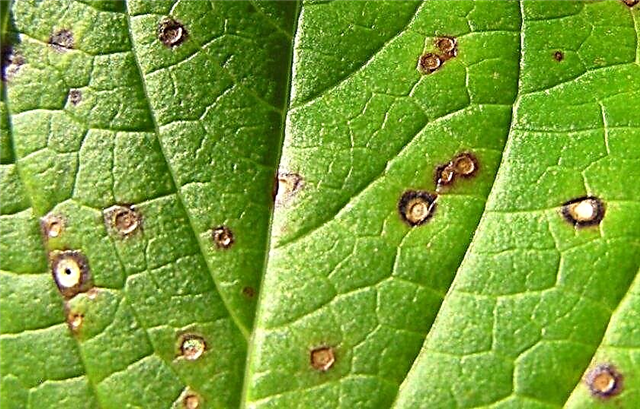
- Slug. You can notice their appearance on the plant along the eaten edges of the leaves and damaged buds. The pest reproduces well in conditions of high humidity and hides in the axils of hydrangea leaves, as well as under the nearest stones in the soil. The slugs are harvested by hand, and to prevent their reappearance, the earth around the bush is sprinkled with dry needles.

- Spider mite. It sucks juice from leaves and young stalks of hydrangea. The surface of the sheet plate is covered with a marble pattern, which leads to premature drying and falling of the green mass.

- Aphid. Insects are located on the lower surface of the leaf, sucking juices out of it. As a result of infection, the plant loses its decorative qualities, begins to wither and may die. Aphids also carry dangerous viral infections.

- Gall nematode. The pest lives in the upper layers of the soil and affects the root system of the bush. A sign of the problem is the drying of the shoots, the slowdown of their growth and the shedding of unopened inflorescences. At the same time, blisters are formed on the roots, which lead to decay of the entire underground part of the plant.
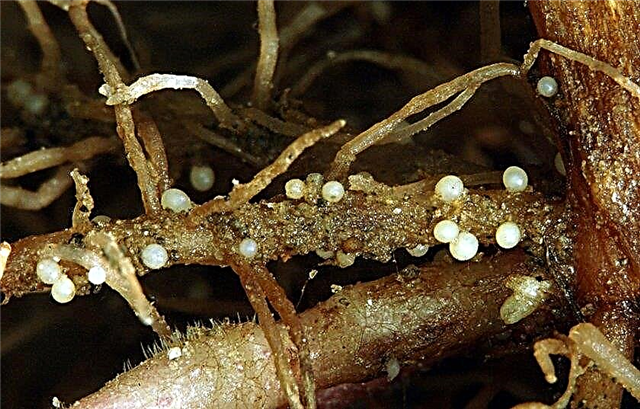
For the treatment of fungal diseases, fungicides are used - Phytosporin, Topaz. Against pests use drugs "Akarin", "Commander", "Tanrek." Medicines are used in accordance with the instructions indicated on the package.
To prevent the occurrence of these problems, it is enough to perform the following actions:
- observe the distance between plants when planting;
- use high-quality planting material;
- remove weeds and loosen the soil in the area of the trunk circle;
- comply with watering and dressing schedules;
- to conduct annual pruning of shoots.
 Panicled Hydrangea Touch of Pink can become a real decoration for any site, annually delighting the gardener with lush and bright flowering. To grow a beautiful and healthy plant, it is enough to adhere to the recommendations listed in the article, performing planting and caring for the bush according to the specified rules.
Panicled Hydrangea Touch of Pink can become a real decoration for any site, annually delighting the gardener with lush and bright flowering. To grow a beautiful and healthy plant, it is enough to adhere to the recommendations listed in the article, performing planting and caring for the bush according to the specified rules.









